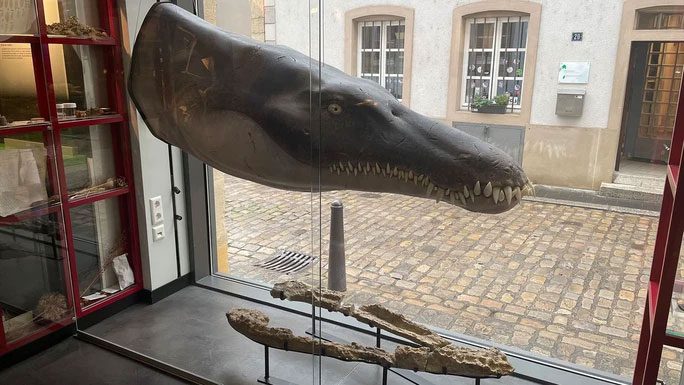The jaw of this monster measures an astonishing 1.3 meters in length. It is a completely new species, described as a “super predator,” sitting at the top of the food chain in the Jurassic oceans.
According to a publication in the scientific journal Scientific Reports, the newly discovered species has been named Lorrainosaurus. It is a new member of the “dinosaurian predator” pilosaur lineage, a distant relative of modern lizards, which dominated the food chain in the oceans for 80 million years.

The head of Lorrainosaurus reconstructed from the lower jaw – (Photo: NATURAL HISTORY MUSEUM OF LUXEMBOURG).
According to Live Science, the first bizarre body parts of this creature were excavated in 1983 in the Lorraine region of northeastern France, but it wasn’t until nearly half a century later that anyone could identify what it was.
A study in 1994 mistakenly classified it as belonging to another known genus of pilosaur, Simolestes, naming the specimen Simolestes Keileni. Only recently have new fossil analysis techniques helped demonstrate that it is completely distinct from other Simolestes species.
This monstrous creature from France is believed to be more terrifying than anything found in the Jurassic oceans, with a jaw length of up to 1.3 meters—0.36 meters longer than the Simolestes—and an estimated body length of about 6 meters.
It has been identified as a completely distinct branch of pilosaur with an unimaginable level of danger.
“It eats whatever it wants,” said co-author Daniel Madzia from the Institute of Paleobiology at the Polish Academy of Sciences.
This monster preyed on ancient sharks, gigantic sea turtles, lizard-like reptiles, and many other unfortunate species that coexisted with it in the Jurassic oceans.
The identification and accurate dating of this creature have pushed back the timeline for the emergence of giant marine reptiles by more than 5 million years. Clearly, these monsters began to emerge right when the Jurassic food chain underwent a significant transformation 175-171 million years ago, following a decline in other apex predator species.


















































